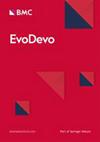寒武纪化石 Pikaia 和脊索动物体节的起源
IF 3.6
2区 生物学
Q1 DEVELOPMENTAL BIOLOGY
引用次数: 0
摘要
中寒武纪化石 Pikaia 有一系列规则的垂直条带,假定其与脊索动物有亲缘关系,可以将其解释为位于连续肌节之间的隔膜。Pikaia是否具有脊索和神经索还不太确定,因为背侧器官在活的脊索动物中没有明显的对应物,是唯一明确界定的延伸身体长度的轴向结构。由于没有脊索作为参照点,神经索的位置只能是猜测,这就引出了一个问题,即专门用于体节神经支配的背神经中枢是如何从更分散的祖先上皮内神经丛中首先产生的。本研究以半脊类动物为参照点对这一问题进行了研究,首先是为了了解半脊类动物提供的有关祖先去骨神经系统组织的信息,其次是扩展 E. E. Ruppert 的分析,以解释为什么会首先进化出像肠鼻领索状的神经折叠。这两项分析都表明,元骨最前端的内侧表面可能是第一体节进化的地点。该分析强调了体支条件在脊索动物中的重要性,即前躯干、hox1表达以及鳃系列和体节的开始之间的联系。可以说,这一特征是评估寒武纪已灭绝类群的有效标准,这些类群与脊索动物(如兽脚类和云南动物)相似,但可能与脊索动物无关。在更多的推测方面,我们讨论了背侧器官的性质,包括它可能是一个将神经和支持功能结合在一个结构中的扩张神经管。本文章由计算机程序翻译,如有差异,请以英文原文为准。
The Cambrian fossil Pikaia, and the origin of chordate somites
The Middle Cambrian fossil Pikaia has a regular series of vertical bands that, assuming chordate affinities, can be interpreted as septa positioned between serial myotomes. Whether Pikaia has a notochord and nerve cord is less certain, as the dorsal organ, which has no obvious counterpart in living chordates, is the only clearly defined axial structure extending the length of the body. Without a notochord to serve as a reference point, the location of the nerve cord is then conjectural, which begs the question of how a dorsal neural center devoted to somite innervation would first have arisen from a more diffuse ancestral plexus of intraepithelial nerves. This question is examined using hemichordates as a reference point, first for the information they provide on the organization of the ancestral deuterostome nervous system, and second, extending the analysis of E. E. Ruppert, to explain why neural infoldings like the enteropneust collar cord would first have evolved. Both implicate the medial surface of the anterior-most part of the metacoel as the likely site for the evolution of the first somites. The analysis highlights the importance of the somatobranchial condition in chordates, meaning the linkage between the anterior trunk, hox1 expression, and the beginning of the gill series and somites. This feature is arguably a valid criterion by which to assess extinct taxa from the Cambrian that resemble chordates (e.g., vetulicolians and yunnanozoans), but may be unrelated to them. In a more speculative vein, the nature of the dorsal organ is discussed, including the possibility that it is an expanded neural tube combining neural and support functions in one structure.
求助全文
通过发布文献求助,成功后即可免费获取论文全文。
去求助
来源期刊

Evodevo
EVOLUTIONARY BIOLOGY-DEVELOPMENTAL BIOLOGY
CiteScore
7.50
自引率
0.00%
发文量
18
审稿时长
>12 weeks
期刊介绍:
EvoDevo publishes articles on a broad range of topics associated with the translation of genotype to phenotype in a phylogenetic context. Understanding the history of life, the evolution of novelty and the generation of form, whether through embryogenesis, budding, or regeneration are amongst the greatest challenges in biology. We support the understanding of these processes through the many complementary approaches that characterize the field of evo-devo.
The focus of the journal is on research that promotes understanding of the pattern and process of morphological evolution.
All articles that fulfill this aim will be welcome, in particular: evolution of pattern; formation comparative gene function/expression; life history evolution; homology and character evolution; comparative genomics; phylogenetics and palaeontology
 求助内容:
求助内容: 应助结果提醒方式:
应助结果提醒方式:


